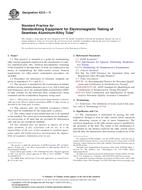Wir benötigen Ihre Einwilligung zur Verwendung der einzelnen Daten, damit Sie unter anderem Informationen zu Ihren Interessen einsehen können. Klicken Sie auf "OK", um Ihre Zustimmung zu erteilen.
ASTM E215-11
Standard Practice for Standardizing Equipment for Electromagnetic Testing of Seamless Aluminum-Alloy Tube
Automatische name übersetzung:
Standard Praxis für die Standardisierung und Baugeräten elektromagnetische Prüfung nahtloser Aluminium-Legierung Rohr
NORM herausgegeben am 1.7.2011
Informationen über die Norm:
Bezeichnung normen: ASTM E215-11
Anmerkung: UNGÜLTIG
Ausgabedatum normen: 1.7.2011
SKU: NS-44478
Zahl der Seiten: 11
Gewicht ca.: 33 g (0.07 Pfund)
Land: Amerikanische technische Norm
Kategorie: Technische Normen ASTM
Kategorie - ähnliche Normen:
Die Annotation des Normtextes ASTM E215-11 :
Keywords:
aluminum alloy, eddy currents, electromagnetic examination, equipment standardization, NDT, nondestructive testing, tubing, Aluminum alloys (tube), Eddy current examination, Electromagnetic (eddy current) testing, Equipment standardization, Nondestructive evaluation (NDE), Seamless aluminum alloy pipe/tube, ICS Number Code 77.040.20 (Non-destructive testing of metals)
Ergänzende Informationen
| Significance and Use | ||||||||||||||
|
The examination is performed by passing the tube lengthwise through or near an eddy current sensor energized with alternating current of one or more frequencies. The electrical impedance of the eddy current sensor is modified by the proximity of the tube. The extent of this modification is determined by the distance between the eddy current sensor and the tube, the dimensions, and electrical conductivity of the tube. The presence of metallurgical or mechanical discontinuities in the tube will alter the apparent impedance of the eddy current sensor. During passage of the tube, the changes in eddy current sensor characteristics caused by localized differences in the tube produce electrical signals which are amplified and modified to actuate either an audio or visual signaling device or a mechanical marker to indicate the position of discontinuities in the tube length. Signals can be produced by discontinuities located either on the external or internal surface of the tube or by discontinuities totally contained within the tube wall. The depth of penetration of eddy currents in the tube wall is influenced by the conductivity (alloy) of the material being examined and the excitation frequency employed. As defined by the standard depth of penetration equation, the eddy-current penetration depth is inversely related to conductivity and excitation frequency (Note 2). Beyond one standard depth of penetration (SDP), the capacity to detect discontinuities by eddy currents is reduced. Electromagnetic examination of seamless aluminum alloy tube is most effective when the wall thickness does not exceed the SDP or in heavier tube walls when discontinuities of interest are within one SDP. The limit for detecting metallurgical or mechanical discontinuities by way of conventional eddy current sensors is generally accepted to be approximately three times the SDP point and is referred to as the effective depth of penetration (EDP). |
||||||||||||||
| 1. Scope | ||||||||||||||
|
1.1 This practice is intended as a guide for standardizing eddy-current equipment employed in the examination of seamless aluminum-alloy tube. Artificial discontinuities consisting of flat-bottomed or through holes, or both, are employed as the means of standardizing the eddy-current system. General requirements for eddy-current examination procedures are included. 1.2 Procedures for fabrication of reference standards are given in Appendixes X1.1 and X2.1. 1.3 This practice is intended for the examination of tubular products having nominal diameters up to 4 in. [101.6 mm] and wall thicknesses up to the standard depth of penetration (SDP) of eddy currents for the particular alloy (conductivity) being examined and the examination frequency being used. Note 1—This practice may also be used for larger diameters or heavier walls up to the effective depth of penetration (EDP) of eddy currents as specified by the using party or parties. 1.4 This practice does not establish acceptance criteria. They must be established by the using party or parties. 1.5 The values stated in inch-pound units are to be regarded as the standard. The values given in parentheses are mathematical conversions to SI units that are provided for information only and are not considered standard. 1.6 This standard does not purport to address all of the safety problems, if any, associated with its use. It is the responsibility of the user of this standard to establish appropriate safety and health practices and determine the applicability of regulatory limitations prior to use. |
||||||||||||||
| 2. Referenced Documents | ||||||||||||||
|
Empfehlungen:
Aktualisierung der Gesetze
Wollen Sie sich sicher sein, dass Sie nur die gültigen technischen Vorschriften verwenden?
Wir bieten Ihnen Lösungen, damit Sie immer nur die gültigen (aktuellen) legislativen Vorschriften verwenden könnten.
Brauchen Sie mehr Informationen? Sehen Sie sich diese Seite an.




 Cookies
Cookies
